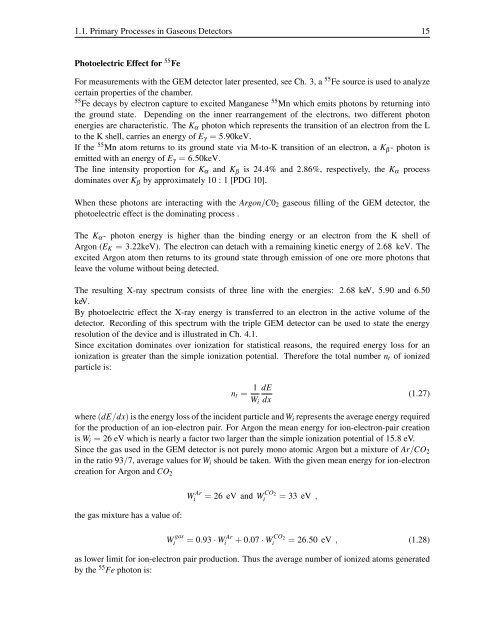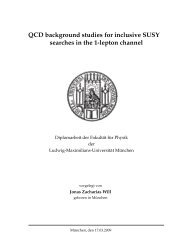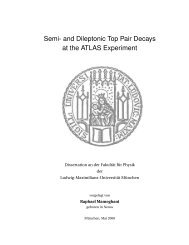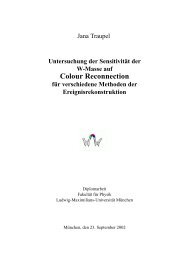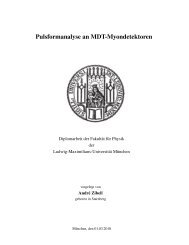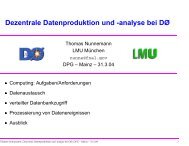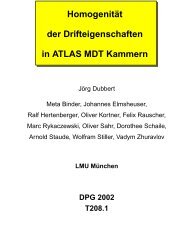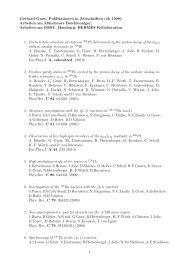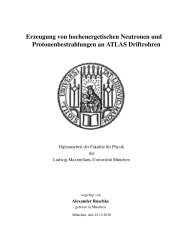development of micro-pattern gaseous detectors – gem - LMU
development of micro-pattern gaseous detectors – gem - LMU
development of micro-pattern gaseous detectors – gem - LMU
Create successful ePaper yourself
Turn your PDF publications into a flip-book with our unique Google optimized e-Paper software.
1.1. Primary Processes in Gaseous Detectors 15<br />
Photoelectric Effect for 55 Fe<br />
For measurements with the GEM detector later presented, see Ch. 3, a 55 Fe source is used to analyze<br />
certain properties <strong>of</strong> the chamber.<br />
55 Fe decays by electron capture to excited Manganese 55 Mn which emits photons by returning into<br />
the ground state. Depending on the inner rearran<strong>gem</strong>ent <strong>of</strong> the electrons, two different photon<br />
energies are characteristic. The Kα photon which represents the transition <strong>of</strong> an electron from the L<br />
to the K shell, carries an energy <strong>of</strong> Eγ = 5.90keV.<br />
If the 55 Mn atom returns to its ground state via M-to-K transition <strong>of</strong> an electron, a K β - photon is<br />
emitted with an energy <strong>of</strong> Eγ = 6.50keV.<br />
The line intensity proportion for Kα and K β is 24.4% and 2.86%, respectively, the Kα process<br />
dominates over K β by approximately 10 : 1 [PDG 10].<br />
When these photons are interacting with the Argon/C02 <strong>gaseous</strong> filling <strong>of</strong> the GEM detector, the<br />
photoelectric effect is the dominating process .<br />
The Kα- photon energy is higher than the binding energy or an electron from the K shell <strong>of</strong><br />
Argon (EK = 3.22keV). The electron can detach with a remaining kinetic energy <strong>of</strong> 2.68 keV. The<br />
excited Argon atom then returns to its ground state through emission <strong>of</strong> one ore more photons that<br />
leave the volume without being detected.<br />
The resulting X-ray spectrum consists <strong>of</strong> three line with the energies: 2.68 keV, 5.90 and 6.50<br />
keV.<br />
By photoelectric effect the X-ray energy is transferred to an electron in the active volume <strong>of</strong> the<br />
detector. Recording <strong>of</strong> this spectrum with the triple GEM detector can be used to state the energy<br />
resolution <strong>of</strong> the device and is illustrated in Ch. 4.1.<br />
Since excitation dominates over ionization for statistical reasons, the required energy loss for an<br />
ionization is greater than the simple ionization potential. Therefore the total number nt <strong>of</strong> ionized<br />
particle is:<br />
nt = 1<br />
Wi<br />
dE<br />
dx<br />
(1.27)<br />
where (dE/dx) is the energy loss <strong>of</strong> the incident particle and Wi represents the average energy required<br />
for the production <strong>of</strong> an ion-electron pair. For Argon the mean energy for ion-electron-pair creation<br />
is Wi = 26 eV which is nearly a factor two larger than the simple ionization potential <strong>of</strong> 15.8 eV.<br />
Since the gas used in the GEM detector is not purely mono atomic Argon but a mixture <strong>of</strong> Ar/CO2<br />
in the ratio 93/7, average values for Wi should be taken. With the given mean energy for ion-electron<br />
creation for Argon and CO2<br />
the gas mixture has a value <strong>of</strong>:<br />
W gas<br />
i<br />
W Ar<br />
i = 26 eV and W CO2<br />
i = 33 eV ,<br />
Ar<br />
= 0.93 · Wi + 0.07 · W CO2<br />
i = 26.50 eV , (1.28)<br />
as lower limit for ion-electron pair production. Thus the average number <strong>of</strong> ionized atoms generated<br />
by the 55 Fe photon is:


